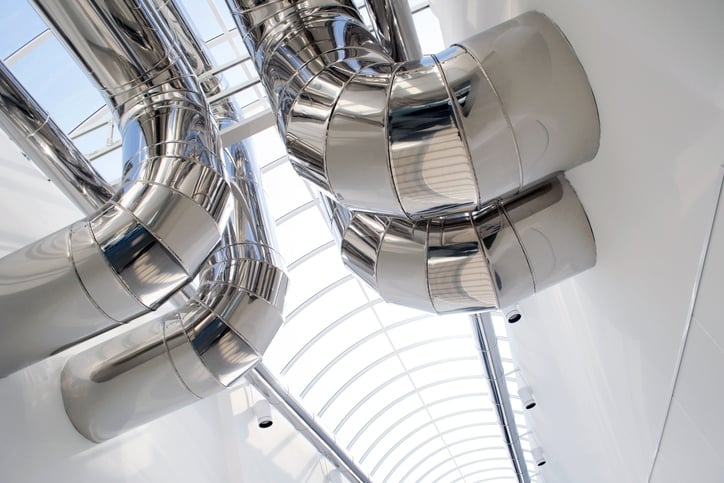Controlling CO2 in Controlled Environment Agriculture

It's almost a rite of passage for any fourth-grade science student — making a terrarium in a jar.
The story is almost always the same — for the first week or two, everything seems to be going great and the plants appear content and growing. But inevitably, the terrariums that weren't set up correctly, say not having enough holes for ventilation poked in their lid, start to take a nosedive. Before too long, the jars very much become a science experiment gone wrong as the plants wither from not having the right balance of CO2 in the environment.
On a much grander scale, the same can happen in controlled environment agriculture. Without proper monitoring and control — coupled with the right tools and technology — the wrong levels of CO2 levels can wreak havoc on plant growth and health.
CO2 & CEA: Fine-tuning Balance
When you look at CO2 in controlled environment agriculture, it has a unique place — one that can make or break the success of an indoor farming operation.
On one hand, it's an element that can create plenty of issues for indoor agriculture just as it does in any other enclosed space. For instance, the wrong levels of CO2 can lead to decreased yields, stunted plant growth, and even crop failures. And with livestock, it can stunt growth rates, lower reproductive performance, and alter feeding patterns.
On the other hand, CO2 is also a vital component for plant photosynthesis. Without exposure to the gas, plants simply can't do their jobs and grow.
For anyone overseeing controlled environment agriculture or designing the systems that make it possible, you know all too well how much time and effort can go into fine-tuning conditions. If any variable (temperature, humidity, lighting, etc.) is out of an acceptable range, it can lead to significant problems for a harvest or yield. And that's no different than what happens in traditional farming — too much rain, extreme temperatures, or a lack of sunlight can all spell trouble for crops at the mercy of Mother Nature.
What's the Ideal CO2 Range for CEA
So what's the ideal range of CO2 in a controlled environment agricultural setting? The answer isn't a one-size-fits-all.
Different plants have different needs, and various stages of growth require varying levels of CO2. Generally speaking, mature plants typically require less CO2 than those in the vegetative stage. And specific crops, such as tomatoes and cucumbers, have been shown to benefit from slightly higher levels of CO2 compared to other crops like lettuce.
In general, it's recommended to aim for a range between 1000-1500 ppm of CO2 for most crops. This can vary based on factors such as the type of crop, lighting intensity, and airflow within the growing environment.
As for livestock that spend a significant amount of time indoors (chickens or pigs) the ideal CO2 range is even lower at around 600-800 ppm.
Advanced CO2 Sensors for Indoor Farming
In a perfect world, controlling CO2 levels for indoor farming operations would be as simple as opening a window and waiting a few minutes.
Unfortunately, it doesn't work that way.
Indoor agriculture — especially for growing vegetables — is a round-the-clock operation, and there's never a time when ambient conditions don't need to be monitored and managed. With the right systems in place and some levels of automation, staying on top of keeping conditions where they need to be is a no-brainer — essentially a computer handles the minute-by-minute of it.
As CO2 is generally managed by HVAC, having advanced & robust CO2 greenhouse sensor technology integrated throughout the climate control system is an absolute must. Not only does this allow for real-time monitoring and adjustments, but it also provides historical data that can inform future decisions and ultimately lead to more efficient operations.
So what agriculture sensor technology do you turn to for keeping CO2 levels at the sweet spot?
That's easy: NDIR (Non-Dispersive Infrared) Sensors.
A Closer Look at NDIR CO2 Sensors for Indoor Ag
NDIR CO2 sensors operate by measuring the amount of infrared light that passes through a gas sample. Since CO2 molecules absorb specific wavelengths of infrared light, the sensor can accurately determine the concentration of carbon dioxide in the air by detecting changes in the light absorption.
This technology offers a direct, reliable method for assessing CO2 levels. Its non-invasive nature and low maintenance requirements further contribute to its predominant use in modern indoor farming operations.
Compared to other CO2 monitoring options, NDIR sensors boast:
-
Accuracy and Reliability: They offer precise CO2 measurements, essential for optimal plant growth, by specifically targeting the gas's absorption spectrum.
-
Minimal Calibration Requirements: Unlike other CO2 sensors, NDIR CO2 sensors are designed to compensate for potential drift during their long, useful lives, reducing the need for frequent recalibration.
-
Easy Integration with Climate Control Systems: Their robust design allows for seamless integration into existing climate control systems, ensuring a stable environment for crops without constant manual oversight.
NDIR sensors for CO2 come in two styles: single-channel and dual-channel.
Single-channel NDIR sensors use one wavelength for CO2 measurement and rely on software algorithms to ensure long-term accuracy. Dual-channel NDIR sensors, however, utilize two wavelengths for measurement, offering built-in drift compensation for enhanced reliability over time.
What's the Best NDIR CO2 Sensor for Indoor Agriculture?
Another easy one: a dual-channel NDIR sensor.
Why?
The dual-channel option is made for applications in which a space is constantly occupied or there are unlikely to be regular CO2 level fluctuations, such as a greenhouse or indoor growing operation. Another way: indoor agriculture is all about keeping conditions under control and consistent, and dual-channel NDIR CO2 sensors are made for environments that don't see much change.
Staying Ahead of CO2 in an Indoor Ecosystem
As it's been said: In nature, nothing exists alone.
The same sentiments apply to indoor agriculture. In essence, all the elements you're trying to manage are connected and affect each other.
When it comes to CO2 management against the other ambient conditions of an indoor agriculture operation, consider:
-
Temperature: CO2 levels and temperature are unquestionably linked. Higher temperatures can enhance CO2 assimilation up to a point, beyond which it can stress plants. Maintaining a balance ensures efficient photosynthesis without overheating.
-
Photosynthesis Rates: The rate of photosynthesis increases with CO2 concentration, but only to a limit. Excess CO2 without adequate light and nutrients doesn't benefit growth and can be wasteful or harmful.
-
Ventilation: Proper ventilation balances CO2 by introducing fresh air and expelling excess humidity and heat. Avoiding over-ventilation ensures CO2 isn't wasted, maintaining its optimal levels for growth.
-
Humidity: CO2 absorption by plants increases with humidity, enhancing growth. However, too high humidity can cause diseases. Balancing humidity with CO2 levels promotes healthy, vigorous plants.
CO2 Management the Easy, Connected Way
Even in an environment where ambient conditions are relatively stable, keeping any metric — from lighting levels to air pressure — within an acceptable range is a full-time job. In fact, it's more than that — it's a 24/7/365 job.
So short of hiring an army of workers to monitor and adjust every aspect of controlled environment agriculture settings, how do you stay ahead of keeping a metric like CO2 in check at all times?
Advanced sensor technology that's also smart.
Integrated into more sophisticated building management and HVAC systems, IoT- (Internet of Things) enabled sensor technology takes the heavy lifting of CO2 management off your plate.
These sensors can be programmed to work with other connected devices to help create an indoor ecosystem that's closer to being completely self-regulating. And added benefits like real-time alerts and historical data tracking make it easier than ever to stay on top of indoor agriculture conditions.
For instance, say there's a freak event that causes CO2 levels to rise beyond normal parameters. With IoT CO2 sensors and air flow sensors in agriculture, not only are countermeasures triggered, but operation managers would also receive a notification through their building management system. Once any potential danger is averted, they'd have the data available to understand what caused the spike in CO2 levels and prevent it from happening again.
What does all of this mean?
For those managing indoor agriculture operations or those designing the systems that support them, IoT-enabled CO2 sensors for greenhouses or other controlled environments allow for a greater level of control over indoor farming. And that opens the doors to improved yields, healthier plants, and more efficient operations overall.
Controlling Controlled Environment Agriculture
Though it's impossible to create an indoor environment with its conditions staying unchanged from an ideal level, combining the right technology with careful management can get you close.
In addition to CO2 sensors, other sensors in agriculture that monitor humidity, temperature, and light levels are all important elements in creating a successful indoor growing operation. The key is finding the best hardware and software solutions to support your efforts in building an indoor ecosystem that's the next best thing to a natural setting.
Let’s Talk About Your Indoor Ag Environment
Speak with one of our sensor engineers today!




